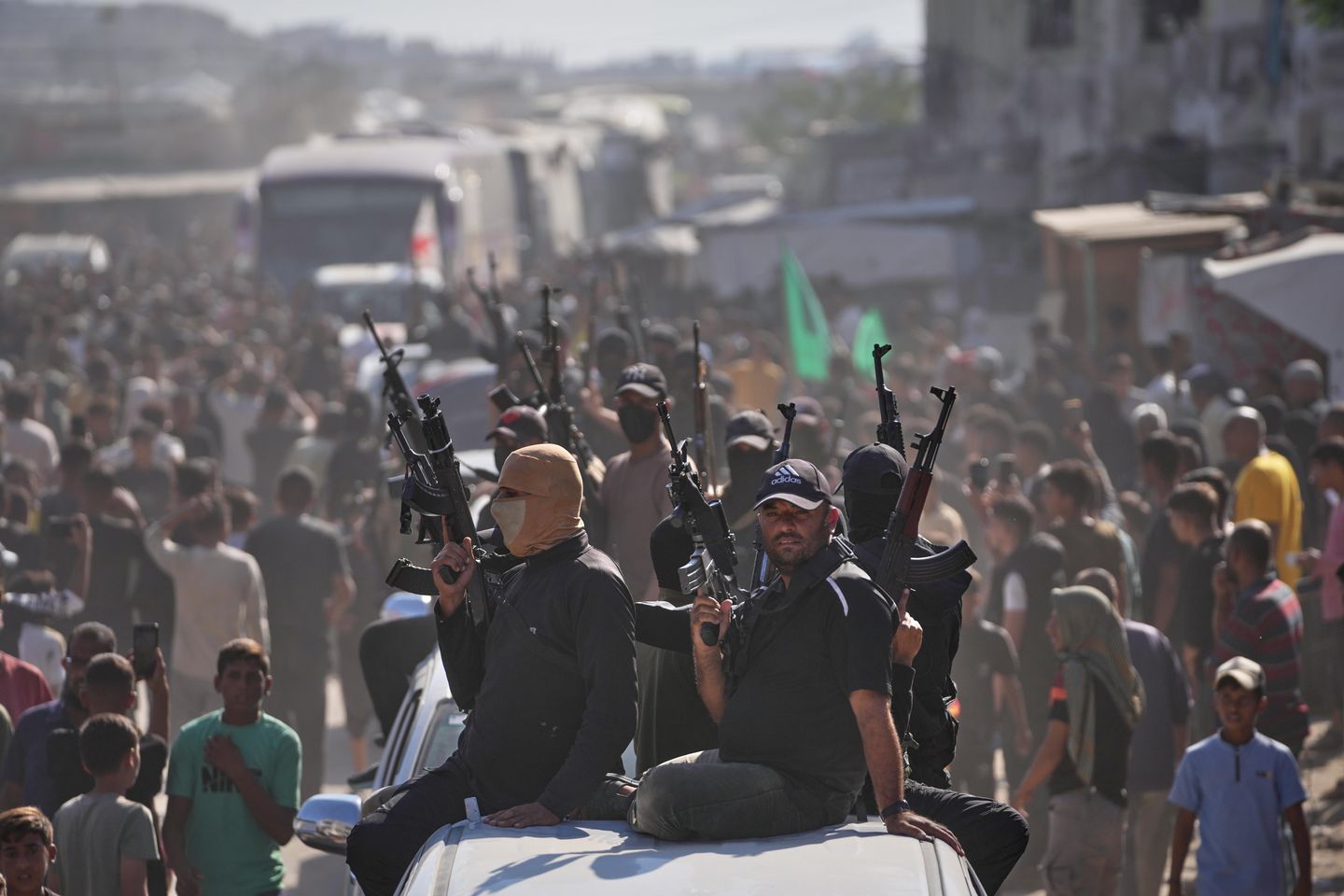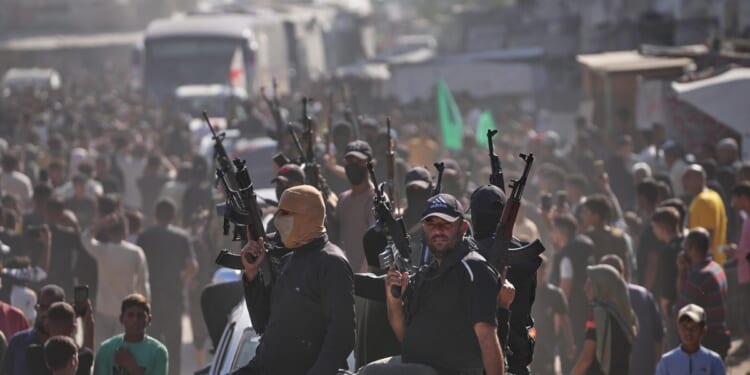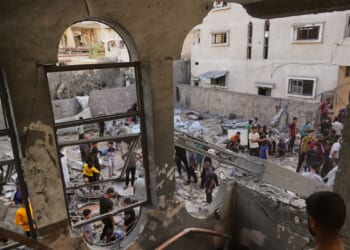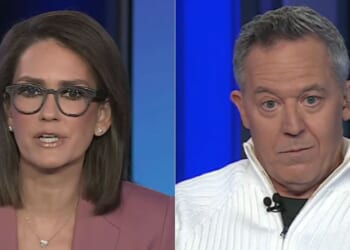
The cold, harsh realities of the Gaza war and the prospect of an ongoing conflict loomed over the Middle East on Tuesday, just a day after the region rejoiced at the release of hostages and President Trump’s celebratory signing of the major Israel-Hamas ceasefire deal.
Although most Arab powers have praised the U.S.-brokered agreement, the post-deal security dynamics in Gaza remain uncertain, with questions swirling over whether or not Hamas will disarm and unease mounting over the prospect of a new Israeli assault if the truce breaks down.
Videos online showed Hamas fighters carrying out executions in a Gaza public square. Hamas militants have also reportedly clashed on multiple occasions with other armed groups inside Gaza, resulting in dozens of casualties.
Israeli officials, meanwhile, confirmed Tuesday that Israel will halve the amount of aid entering Gaza and will delay the opening of the Rafah border crossing because of Hamas’ failure to release the bodies of hostages killed in captivity. Israel is awaiting the return of at least 23 bodies.
Hamas on Monday released the 20 living hostages remaining in Gaza. Israel also released nearly 2,000 Palestinian prisoners on Monday.
Israel will now only allow around 300 trucks carrying humanitarian aid into Gaza this week. No fuel will be allowed into Gaza, with small exceptions for infrastructure needs.
Hamas has also accused Israel of violating the ceasefire this week after at least nine Palestinians were killed in Gaza City. The Israeli military said its troops opened fire after several Palestinians approached a truce border laid out by the peace deal.
Amid the fragile peace, Iran, Hamas’ primary backer, has dismissed President Trump’s proclamation of peace in the Middle East, saying his words don’t align with his administration’s actions.
“One can hardly be branded as President of Peace while provoking endless WARS and aligning with WAR criminals,” Iranian Foreign Minister Abbas Araghchi wrote on X Tuesday. “Mr. Trump can either be a President of Peace or a President of War, but he cannot be both at the same time.”
The Iranian reaction contrasts with the praise that Mr. Trump’s deal has garnered from around the region, as even Israel’s historic enemies pray for a strong peace.
Egypt, which mediated the Gaza deal with Turkey and Qatar, has been one of the most vocal proponents of the agreement. The Egyptian government has been preparing to play a major role in Gaza’s reconstruction for months. The Rafah border crossing will likely be one of the major aid transit zones as the peace deal progresses.
“We pursue a comprehensive vision of peace, security, and shared prosperity in the region, grounded in the principles of mutual respect and shared destiny,” Egypt wrote in a joint statement with the other signatories of the deal. “In this spirit, we welcome the progress achieved in establishing comprehensive and durable peace arrangements in the Gaza Strip, as well as the friendly and mutually beneficial relationship between Israel and its regional neighbors.”
Additionally, state-owned Egyptian construction firms see the reconstruction effort as a major economic opportunity, which would bring major funds to Cairo and possibly strengthen Egypt-Israel relations in the process.
Turkey, too, has emerged as a major, albeit guarded, cheerleader for the deal. President Recep Tayyip Erdogan stressed that Ankara will carefully watch over the implementation of the agreement. He added that Turkey’s ultimate goal is to work toward the establishment of a Palestinian state, something that could put Mr. Erdogan at odds with Israeli leadership.
“As Turkiye, we will closely monitor the agreement’s strict implementation and continue to contribute to the process. Similarly, we will continue our struggle until an independent, sovereign, and geographically integrated State of Palestine is established in Palestine, based on the 1967 borders, with east Jerusalem as its capital,” he said last week.
Ankara does not consider Hamas to be a terrorist organization and has hosted fighters and leaders from the group for years despite Israeli objections.
Mr. Erdogan actively led the opposition to Israeli Prime Minister Benjamin Netanyahu’s participation in Monday’s peace summit in Egypt, where the agreement was signed. Palestinian National Authority President Mahmoud Abbas was present at the signing.
Beyond the agreement’s brokers, Lebanon has viewed the agreement as a good sign. If the deal holds, it could pave the way for Israel’s withdrawal from Lebanon, where its troops maintain a noticeable presence.
On Monday, Lebanese President Joseph Aoun said that Lebanon and Israel must use the moment to hammer out a comprehensive peace agreement that would see Hezbollah, the Lebanon-based Islamic militant group aligned with Hamas, lay down its arms and the Israeli military leave Lebanon.
“Conditions are moving toward negotiations to achieve peace and stability,” Mr. Aoun said. “Therefore, we say that through dialogue and negotiations solutions can be reached.”
Syria, still emerging from the ashes of the Assad regime, has been overtly optimistic about the agreement.
As negotiators finalized the Gaza deal over several months, Syrian Interim President Ahmed al-Sharaa and his diplomats had also worked for months to iron out a disengagement agreement that could stabilize the Syrian-Israeli border.
Mr. al-Sharaa’s support for the deal could improve his standing among those in Israeli leadership, who have expressed concerns that the former Islamic militant leader has not left his fundamentalism in the past.
The October agreement ends one of the most deadly periods in the Israeli-Palestinian conflict, which began after Hamas militants launched a series of deadly attacks on October 7, 2023. Hamas killed nearly 1,200 Israelis during the attacks and took hundreds hostage.
Over the course of the war, approximately 67,000 Palestinians have been killed, according to the Gaza Health Ministry, which is under Hamas control. Israeli authorities dispute those numbers and say they are inaccurate.
Almost 2,000 Israelis have been killed during the conflict, according to the Israeli Ministry of Foreign Affairs.
The agreement itself contains three phases, which include provisions for a robust ceasefire, distribution of humanitarian aid, demilitarization of Hamas, governmental reforms within Gaza led by Palestinian technocrats and overseen by an international body and the eventual recognition of a Palestinian state if certain reforms are met.










